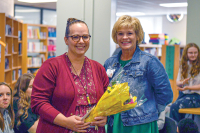Molding a passion
 Standing in her Dillsboro studio, potter Zan Barnes can’t help but smile. “If you told me in high school that this is what I’d be doing, I’d have laughed in your face — absolutely not,” the 32-year-old said.
Standing in her Dillsboro studio, potter Zan Barnes can’t help but smile. “If you told me in high school that this is what I’d be doing, I’d have laughed in your face — absolutely not,” the 32-year-old said.
A second-generation potter, Barnes is tucked away in her own little Zen den. Next to her at all times is Zelda, a rescued Great Dane as gentle as she is large. The wooden structure is long and winding, with a low-hanging roof, where blocks of clay, buckets of water, countless shelves and finished items reside — all under a grove of trees, a stone’s thrown from the main house of the Riverwood Shops along the Tuckasegee River.
Holding heritage in his hands
 It was a summer job that literally molded itself into a future.
It was a summer job that literally molded itself into a future.
Cowee Pottery School forming
 A group of friends have come together to create a non-profit entity to operate a new pottery school in the Macon County Heritage Center at the old Cowee School.
A group of friends have come together to create a non-profit entity to operate a new pottery school in the Macon County Heritage Center at the old Cowee School.
Potters converge on Dillsboro Nov. 6
The Western North Carolina Pottery Festival expects record attendance this fall as the juried festival continues to attract master potters from across the U.S.
This year’s event will be held from 10 a.m. to 4 p.m. on Saturday, Nov. 6, on the streets of downtown Dillsboro.
The festival features 42 clay artists, each demonstrating their craft throughout the day; roughly half of the potters hail from the mountains of North Carolina and Tennessee, while the other half are from as away as: Texas, Iowa, Wisconsin, New Jersey, Illinois and Ohio.
“The festival has taken off higher than we ever imagined,” said organizer Joe Frank McKee of Dillsboro’s Tree House Pottery. “Attendance increases each year and the potters who apply get better and better. What started as a local pottery festival has blossomed into more of a regional and national pottery festival.”
Admission is $3 and includes a ticket for a day-long raffle. Children under 12 are admitted free.
828.631.5100, or www.wncpotteryfestival.com. For lodging information call the Jackson County Visitors Center at 800.962.1911.
WNC Pottery Festival is Nov. 6
The sixth annual Western North Carolina Pottery Festival is set for Saturday, Nov. 6, in Dillsboro.
This juried festival showcases more than 40 master potters demonstrating a variety of techniques.
The WNC Pottery Festival was established in 2005 by Travis Berning and Joe Frank McKee of Tree House Pottery and Brant Barnes of Riverwood Pottery. The show’s concept is for potters to interact with the public through demonstrations and sharing their general knowledge of clay. It also gives pottery collectors a chance to meet and take home a piece of pottery from their favorite artists.
This year, potters from as far away as Texas, Florida, Michigan and New Jersey are exhibiting their wares.
Steven Hill, this year’s featured potter, has been a professional studio potter since 1974. He started working out of a backyard studio and selling his work, mostly at art festivals. By the mid 1990’s he was looking for a way to expand his studio, to begin a resident artist program for aspiring potters, and to provide space for other ceramic artists to work.
Red Star Studios became the home of Steven Hill Pottery from 1998 to 2006. Hill now lives in Sandwich, lll., and has founded Center Street Clay with his partner Kim Miner. This is a studio and residential workshop facility.
Hill has been single-firing his functional stoneware since 1972. Although at times it is frustrating to glaze raw pots, he finds it encourages directness and spontaneity in his work.
Hill received his BFA from Kansas State University in 1973. His work is featured in nationally juried shows and in many ceramics books. He has taught more than 200 workshops throughout the United States and Canada and has been published multiple times. For more information about Steven Hill, Center Street Clay and his workshops visit www.centerstreetclay.com.
A Clay Olympics will be held on Friday, Nov. 5, from 1-3 p.m. at Treehouse Pottery. Prizes will be awarded to the winners in this throwing contest.
Festival hours are 10 a.m. to 4 p.m. rain or shine. Admission is $3 per person and includes a ticket for a day-long raffle. Kids under 12 get in free.
For festival information call Tree House Pottery at 828.631.5100.
Joel Queen draws on many sources for artistic inspiration
Many who walk into Joel Queen’s gallery mistakenly assume the artwork there solely represents Cherokee tradition.
After all, Queen comes from a long line of Cherokee potters and basketmakers who passed down their art to him as soon as he was able to crawl. And he’s one of Cherokee’s most prominent artists — among the few to successfully run his own gallery and to teach at the Southwestern Community College’s Oconaluftee Institute of Cultural Arts.
But looking closer, it becomes clear that Queen’s artistic vision extends far beyond the Qualla Boundary. His work is as much inspired from Greek vessels, Egyptian sculptures, and Celtic designs as aesthetic traditions from Cherokee and the Southeast.
Queen is just as interested in seeing what Cherokee artists produce as what artists on the other side of the country are up to. He loves traveling across the nation with his family, competing at art shows like at the Sante Fe Indian Market, especially for this purpose.
“The competition keeps me on my toes,” said Queen. “I thrive on it. If I don’t win one year, I’m going to have to do something better next year. That part of it, I really love.”
Even if he doesn’t win, though, the art market provides Queen the perfect opportunity to observe new artistic traditions as they are being formulated.
Queen, along with fellow artist and friend John Grant, decided to create Cherokee’s own annual art market because they saw it as integral to bringing fresh ideas to the region’s art scene.
“The only way art advances is to be able to see what’s going on outside of here,” said Queen, adding that the art market has the additional benefit of boosting the local economy.
An ongoing education
Queen had learned the craft of basketmaking from his grandmother when he was just 5 years old and later fell in love with sculpture. But when Queen settles down to work in one of his two studios, he doesn’t limit himself to just one, or even two, kinds of media.
Queen credits his high school art teacher for showing him how to diversify, which ended up complementing Queen’s own personality in the end.
“It was very eye-opening for me to be able to work in leatherwork, silverwork, clay and paintings,” said Queen.
“... I don’t like being confined. I like being able to express how I feel through different media.”
Luckily for Queen, that versatility has been useful in a volatile economy, when one medium might not sell as well as another.
With a diverse skill set in tow, Queen set out for his next challenge, large-scale pieces — what later became his signature style. Since many artists didn’t like to work large at the time, Queen had to resort to self-teaching to learn to build such heavy pieces.
“Large pieces are more challenging. That’s why I like doing them so much,” said Queen. “It keeps it interesting. It’s very easy for me to lose interest if there’s not a challenge to it.”
Now, Queen can create sculptures 10 to 12 feet tall as well as he can build miniature pieces as small as 2 or 3 inches tall.
Queen also hand builds his pottery, rather than throwing it on the wheel. Pots won’t be perfectly symmetrical this way, but each piece is unique, different from the one before. Though hand building was slow going at first, Queen learned techniques to speed up the process, so he can create at nearly the same rate as an artist who wheel throws.
“I’m not knocking wheel throwing work,” said Queen. “It’s still beautiful and takes talent to do it, but hand building is just a totally different area.”
For one thing, when the electricity goes out, Queen can go right on creating.
“As long as you got wood, you can still burn the pot,” said Queen.
A potter’s calling: For Sarah Rolland, the process is as rewarding as the product
By Sarah Kucharski • Staff Writer
Sarah Rolland first connected with clay on an emotional level. With lunch plans to meet a friend who was taking a course in Haywood Community College’s craft program, Rolland walked into the school’s pottery studio — her curiosity immediately was piqued.





